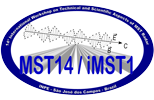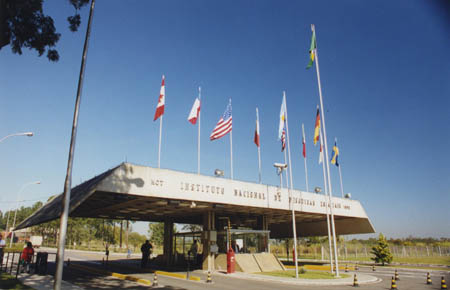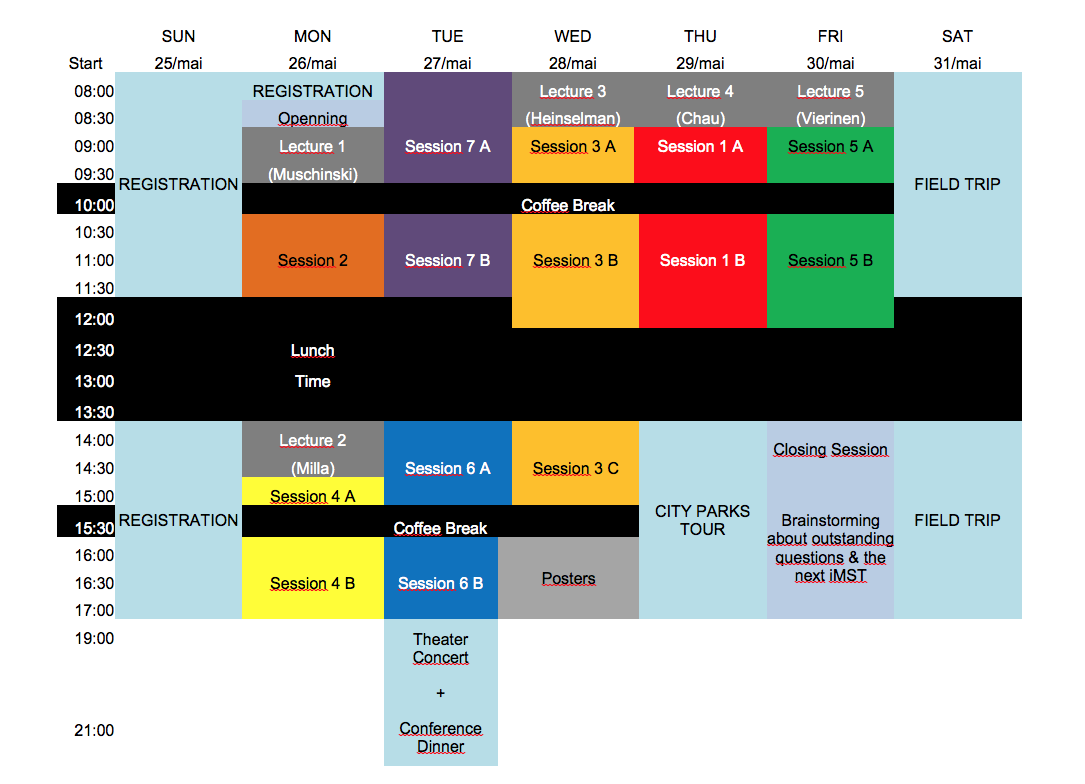Scientists, engineers, technical experts, theoreticians, students, all united in one forum for MST radar studies
- this is what has been special about the series of MST workshops.
Previous workshops have been held in diverse locations like India, Peru, the USA, UK, France, Canada and Germany.
The focus of the upcoming iMST workshop in São José dos Campos (SP) will be meso/strato/tropospheric
and ionospheric coherent scatter radars, but contributions from related areas, such as incoherent scatter probing,
collaborative studies using radars and other instruments like lidars and in-situ studies, and relevant modeling
efforts will all be welcome.
Contributed and invited talks will be organized in the following sessions:
- Meteorology and forecasting/nowcasting.
- MST scattering, micro-scale processes and turbulence.
- Ionospheric irregularities in E and F regions.
- Coherent and incoherent scatter radar techniques, ionospheric sounders and imagers.
- New instruments, signal processing, and quality control.
- Meteor studies and observations.
- Middle Atmosphere Dynamics and Structure.
We especially encourage papers involving multi-instrument applications which include MST radars,
wind profilers and ionospheric coherent scatter radars (e.g. radars/forecast models, radars/lidars,
radars/in situ (rockets or satellites), radars/airglow imagers, radars/satellites, etc.) in all sessions.
The program will also integrate several invited tutorial lectures throughout the workshop, which we anticipate
will be of interest to all participants, but will be of particular importance to students and those new to the field.
The workshop will also offer tutorial lectures/keynotes that will be of interest to all participants.
More details about the content of these sessions are given
HERE
- Meteorology and forecasting/nowcasting.
Session Chairs: Luiz Augusto Toledo Machado, Bronwyn Dolman
MSO: David Hooper
Topics: This session focusses on all meteorological phenomena of the boundary-layer, troposphere,
and lower-stratosphere that are observed by wind-profiling radars - or that are of relevance to wind-profiler observations.
The ability of these radars to continuously measure winds at intervals as small as a few minutes remains a key strength.
Although it is possible to launch radiosondes as frequently as hourly during limited campaign periods, routine observations
are seldom made at intervals of less than 12 hours. Consequently, radar measurements have played a dominant role in
observational studies of the shorter-period gravity waves. Moreover, national meteorological services are increasingly
looking to these radars as an alternative to radiosondes for routine observations. The radars are competitive in terms of
both cost and accuracy of measurements. They are also more-likely to capture the highest-impact weather events, which
seldom last for more than a few hours at any location. These factors are becoming increasingly relevant as the resolution
of numerical weather prediction models continues to improve. The radars are also capable of providing more than just winds.
Under suitable circumstances, they can provide information about atmospheric stability, humidity fields, precipitation, and
turbulence.
Suitable topics for this session include:
- weather systems and related synoptic- and meso-scale phenomena
- gravity wave generation, propagation, interaction, and dissipation (for altitudes no higher than the lower stratosphere)
- turbulence (in the context of atmospheric structure rather than of the scattering mechanism)
- wind-profiling networks
- data assimilation, nowcasting, and forecasting
- water vapour, clouds, convection, and precipitation (in the context of atmospheric structure rather than of the scattering mechanism)
- observations made by complementary instruments
- special observation campaigns
- MST scattering, micro-scale processes and turbulence.
* This session is dedicated to memory of Prof. Ben Balsley
Session Chairs: Gerald Lehmacher, Andreas Muschinski
MSO: Phillip Bruce Chilson
Topics: There is a long and rich history of using radar across a wide range of frequency
bands to investigate atmospheric turbulence along with small- and micro-scale processes. Results from theoretical,
modelling, and observational studies have convincingly demonstrated the utility of using MST radar to investigate a
multitude of such processes including wind-shear-induced turbulence; the presence of steep vertical gradients in dynamic
and thermodynamic fields; dynamic instabilities and their role in the production of turbulence; impacts of charged ice
particles on the movements of free electrons near the mesopause; the decay plasma trails created by ablating meteors;
vertical transport of momemtum; and many others. To better understand these and other related atmospheric phenomena,
the MST research community has continued to innovate radar and signal processing technologies and develop novel ways
of integrating observations from complementary instruments. These include improvements to the spatial and temporal
resolution of radar through the introduction of larger antennas; higher power transmitters, sophisticated wave forms,
and interferometric and imaging techniques; detailed studies of factors contributing to Doppler spectrum widths and
backscattered signal power; and utilizing techniques that exploit intrinisic scattering properties of the atmosphere
such as aspect sensitivity. Examples of complementary observations include in-situ measurements from instrumented
balloons, rockets, aircraft (manned and unmanned), and towers. This session aims to focus on topics related to
radio-wave scatter, atmospheric turbulence, and small- to micro-scale atmosheric phenomena. The session is dedicated
to the memory of Ben Balsley and his innovative work in these areas and the significant and lasting impact that he has
had and continues to have on our community. In keeping with the legacy of Ben Balsley’s style of research, contributions
with a focus of collaborative investigations (field campaigns, multi-institutional studies, multi-sensor observations) from
the boundary layer to the mesosphere are particularly welcomed.
- Ionospheric irregularities in E and F regions.
Session Chairs: Amit Patra and Danny Scipión
MSO: Jorge L. Chau
Topics: Research on ionospheric plasma irregularities has benefited greatly from an advancement in the
knowledge and application of radar techniques that measure the coherent echoes coming from plasma irregularities. Observational
capability has been advanced from a single beam slit camera mode to electronic beam-scanning capability. This provides
two-dimensional spatial images of the irregularity distribution, in-beam imaging of the spatial distribution of the small
scale structures, application of aperiodic pulse for accurate spectral measurements for overspread targets, viz., F region
turbulence, bi-static radar technique to estimate electron density profile, etc. These techniques have also been used to
diagnose the ionosphere effectively, i.e., measure physical parameters that are usually measured by incoherent scatter radars
or in-situ probes. Coordinated observations made using incoherent scatter technique, meteor/MF radar, lidar, and in-situ
measurements have advanced our understanding remarkably. While significant progress has been made, there remain many unresolved
issues of which several are mutually coupled. They include equatorial spread F (ESF) irregularities, irregularity processes
in the daytime and nighttime valley region (around 150 km), auroral and equatorial electrojet processes and associated plasma
irregularities, midlatitude spread F irregularities and their coupling with E region. In addition, there are vertical and
lateral coupling effects arising from lower atmospheric forcing, e.g., tidal, gravity wave, and planetary scale wave effects,
including the Sudden Stratospheric Warming. Coherent radar observations for diagnosing the ionospheric state parameters and
validation during these events, would be of great interest. This session welcomes all scientific and technical papers dealing
with these issues and encourages multi-technique approaches to address them. In addition, coordinated observations in campaign
mode addressing global scale issues, such as high latitude low latitude coupling, effect of the medium scale traveling ionospheric
disturbances (MSTID) and tropical/extra-tropical wave forcing on ESF, would be of interest to the community at large.
- Coherent and incoherent scatter radar techniques, ionospheric sounders and imagers.
Session Chairs: Marco Milla, Mike Nicolls
MSO: Thomas Ulich
Topics: Coherent as opposed to incoherent radar scattering from distributed atmospheric/
ionospheric targets can be described under a single formalism based on the radiation
of accelerated electrons obeying different types of statistics. Coherent and incoherent
scattered radar signals can likewise be processed using identical techniques and
algorithms. Inferences made from radar spectra and ACF obtained under coherent and
incoherent scattering will have commonalities and distinctions reflecting the differences
in the underlying statistics of the re-radiating electrons causing the scatter. This session
will aim to have invited papers and contributions focusing on synergistic and contrasting
aspects of coherent and incoherent scatter and their advanced applications. Papers
focusing on the synergies between different coherent scatter types and ionospheric
sounders and imagers are also to be included.
- New instruments, signal processing, and quality control.
Session Chairs: Fabiano Rodrigues, Juha Vierinen
MSO: Ralph Latteck
Topics: Instrument design and performance, signal processing algorithms and data quality control are the basis of
remote sensing of the MST region using atmospheric radars. Advances in radar technology allow the deployment of new and modern
phased-array atmospheric and ionospheric radar systems such as PANSY in Antarctica, MAARSY in northern Norway, EISCAT 3D in
Scandinavia or the AMISR systems. Several existing radar facilities are expected to be or were lately upgraded for new capabilities.
This session will provide a forum for discussing the application, design, implementation, and engineering aspects of new or upgraded
MST and Incoherent Scatter radar systems as well as related signal processing algorithms and quality control methods. Beside the
introduction to completely new planed or installed radar facilities this also includes the development of new radar system components
as e.g. transceivers, receivers or digitizers. New approaches to signal-processing or the re-evaluation of older or existing techniques
as used for e.g. the rejection of poor data or outliers or filtering should be discussed as well in this session. The session is directed
to develop synergies between the various user groups which study the lower, middle and upper atmosphere and the ionosphere.
The main topics of the session are:
- new radar designs and installations
- new radar sub-components (transceiver, receivers, digitizers)
- upgrades of existing radar facilities
- new approaches to signal-processing
- re-evaluation of signal-processing and analysis techniques
- Meteor studies and observations.
Session Chairs: Diego Janches, Rob Weryk
MSO: Wayne Hocking
Topics: Meteor studies have had a chequered history, from a very active period prior to the 1970's,
to a relative calm in the 1980's and early 1990's, and then an explosion of research from the late 1990's.
Meteors now have many uses, both for astronomical studies as well as tracers and samplers of upper atmosphere chemistry
and dynamics. Their potential impact on spacecraft and satellites is also becoming more important. The ability to routinely
measure tens of thousands of meterors per day, and to see echoes via non-specular processes, has opened doors to a great many
new studies. Powerful new computer simulations have also allowed new insights into meteor-trail formation, ablation modelling,
and trail evolution.
In this session, we will consider papers on any aspect of meteor science as long as MST radar is involved in some way.
Topics may include both specular and head echo studies, as well as modelling of the processes of trail formation and
radio-wave scatter. Meteor chemistry, especially the very high-temperature chemistry involved in overdense trail formation and
destruction, is also important.
Atmospheric parameters deduced from meteor studies, such as winds and temperatures, and their resulting dynamics, is also still
an area of active interest. Tides and planetary-wave studies are also sought. In addition, papers in the new and growing field
of momentum-flux and small-scale dynamical studies using meteor methods are sought.
Some more powerful MST-type radars also appear to be able to detect signatures of space debris entering the atmosphere,
and if these are confirmed, it gives yet another tool to the meteor tool-box. Papers in this area are certainly of interest.
Finally, the number of dedicated meteor radar is growing steadily, as well as the number of applications of meteor studies on existing equipment.
Reports of these studies are encouraged, although emphasis will be given to new networks that have been developed, allowing extensive multi-site studies.
Areas of particular importance are:
- Specular echoes
- Head echoes
- Non-specular scatter
- Formation of meteor trails, ablation modelling and radio scatter
- Meteor Chemistry
- Atmospheric winds studied via meteor trails (concentration on basic science)
- Atmospheric temperatures deduced from meteor trails
- Momentum flux, small scale dynamics, turbulence from meteor trails
- Space debris studies using MST radar
- New meteor networks
- Some limited astronomical studies (may be included if they were made with MST type radars).
- Middle Atmosphere Dynamics and Structure.
Session Chairs: Masaki Tsutsumi, Alan Liu
MSO: Iain Reid
Topics: The middle atmosphere, the region between 10 and 100 km, remains a critical region of study of the
coupling between the lowest part of the atmosphere, the troposphere, where significant gravity wave generation takes place,
and the thermosphere. It is also the region that shields the surface from a major part of the ionizing radiations from the Sun.
The strong interplay between the chemistry, dynamics and thermal structure of the middle atmosphere, and the potential for
changes in these relationships in a changing climate scenario, underscore the importance of better understanding the region.
Indeed, there are already indications of long-term changes in the mean winds, gravity wave activity and electron densities
in parts of the region. Radar studies have contributed significantly to an improved understanding of the Middle Atmosphere
and its important role. However, the region between about 20 and 50 km, a significant part of the Middle Atmosphere, remains
inaccessible to radar. For this reason, coordinated studies using a variety of techniques, including balloon borne instruments,
rockets, lidar, satellite observations and modeling are required to fully understand it. In this session, standalone radar
studies, as well as coordinated multi-instrument investigations of the 10 to 100 km height region are particularly encouraged.
Topics of particular interest include both case studies and climatologies of turbulence, gravity waves, tides and planetary
waves, and possible long-term changes and coupling from the troposphere to the thermosphere.





